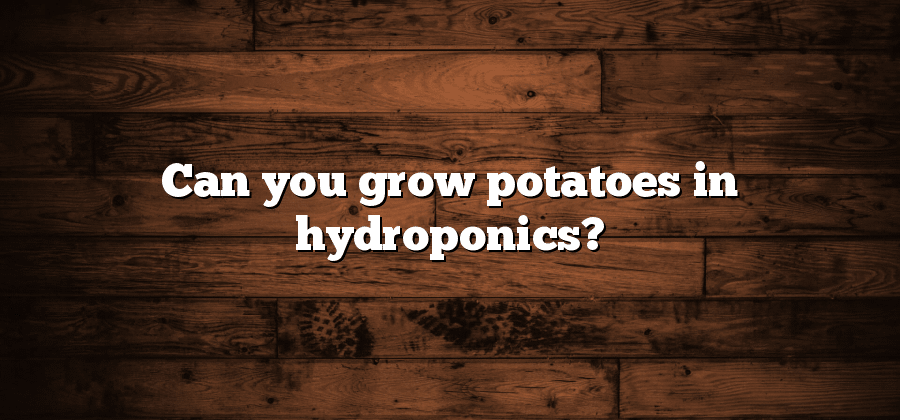Understanding Hydroponics for Potato Cultivation
Hydroponics, a soilless cultivation technique, has gained significant popularity in recent years for growing various crops including potatoes. This innovative method involves providing all essential nutrients directly to the plant roots through a water-based solution. By eliminating the need for soil, hydroponics offers several advantages, such as more controlled growing conditions, higher yields, and reduced water usage.
One key concept in hydroponics is the use of nutrient solutions, which are carefully formulated to provide the necessary elements for plant growth. These solutions are typically made up of a precise blend of macronutrients (such as nitrogen, phosphorus, and potassium) and micronutrients (such as iron, boron, and manganese). The concentrations of these nutrients can be adjusted based on the specific requirements of potato plants, ensuring optimal nutrition is provided at each stage of growth. In addition, pH levels of the nutrient solution must be monitored and adjusted as needed to maintain optimal conditions for nutrient absorption.
Choosing the Right Potato Varieties for Hydroponics
When it comes to choosing the right potato varieties for hydroponics, there are several factors that need to be considered. One of the most important considerations is the growth habit of the potato plant. Some varieties, such as determinate varieties, have a compact, bushy growth habit and are ideal for smaller hydroponic systems. On the other hand, indeterminate varieties have a more sprawling growth habit and are better suited for larger systems with ample space for the vines to spread. Understanding the growth habit of different potato varieties can help determine the most suitable ones for your hydroponic setup.
Another factor to consider when choosing potato varieties for hydroponics is the time to maturity. Different potato varieties have varying maturation times, ranging from early-season to late-season varieties. Early-season varieties typically have a shorter time to maturity, which means they can be harvested sooner. This is particularly beneficial for those looking for faster crop turnaround in their hydroponic systems. On the other hand, late-season varieties take longer to mature but tend to produce higher yields. Carefully consider the time to maturity of different potato varieties to ensure they align with your desired harvest timeline and goals for your hydroponic system.
Building the Ideal Hydroponic System for Potatoes
To ensure successful potato cultivation in a hydroponic system, it is essential to build an ideal setup that meets the specific needs of these plants. One of the first considerations when constructing a hydroponic system for potatoes is the choice of growing containers. Opt for containers that are spacious enough to accommodate the root system of the potatoes while promoting good airflow. This is crucial in preventing the development of diseases caused by excessive moisture.
In addition to the containers, an efficient irrigation system is vital for maintaining the proper moisture levels in the hydroponic system. Drip irrigation is a popular choice for potato cultivation as it allows for precise water delivery directly to the roots. Consider incorporating a timer into the irrigation system to ensure consistent watering intervals and prevent over- or under-watering. Furthermore, selecting a suitable growing medium is crucial, as it will provide the necessary support for potato plants while allowing for proper nutrient absorption. Some recommended options include perlite, coconut coir, or a mixture of these two, as they facilitate drainage and aeration, supporting healthy root development.
Nutrient Solutions: Providing Essential Elements for Potato Growth
Potatoes are a nutrient-rich crop that requires specific elements to thrive in a hydroponic system. Providing essential nutrients is crucial to ensure healthy growth and high yields. The nutrient solution used in hydroponics plays a vital role in meeting the nutritional needs of potato plants.
The nutrient solution for potato cultivation typically includes macronutrients such as nitrogen, phosphorus, and potassium, as well as secondary nutrients like calcium and magnesium. These elements are essential for key plant functions, such as photosynthesis, root development, and the production of starch and sugars. Additionally, micronutrients like iron, manganese, and zinc are also necessary in smaller quantities for proper plant growth and development.
Maintaining an optimal balance of nutrients in the solution is essential for maximizing potato growth and productivity. Regular monitoring and adjustment of the nutrient solution’s pH and nutrient levels are necessary to prevent deficiencies or toxicities. By providing the correct elements in the right amounts, growers can ensure that their hydroponic potato crops have the best possible chance of thriving.
Managing Light and Temperature in Hydroponic Potato Cultivation
Light and temperature are crucial factors to consider when cultivating potatoes through hydroponics. Proper management of these variables is essential for the successful growth and development of the potato plants.
When it comes to light, potatoes require a balanced exposure to both natural and artificial light sources. The ideal lighting conditions for potato cultivation involve providing the plants with around 12 to 16 hours of light per day. This can be achieved by using a combination of natural sunlight and supplemental artificial lighting, such as high-intensity discharge (HID) lamps or light-emitting diodes (LEDs). Additionally, it is important to ensure that the light intensity is adequate for the plants, as insufficient light can lead to weak and elongated stems, reducing overall crop yield.
Temperature is another crucial factor to manage in hydroponic potato cultivation. Potatoes thrive in moderate temperatures, typically between 60 to 70 degrees Fahrenheit (15 to 21 degrees Celsius). It is important to maintain a consistent temperature within this range to promote healthy growth and development. Fluctuations in temperature or exposure to extreme heat or cold can stress the plants and negatively impact their growth. A controlled environment, such as a greenhouse or indoor growing space, can help regulate temperature levels and protect the potato plants from adverse weather conditions.






